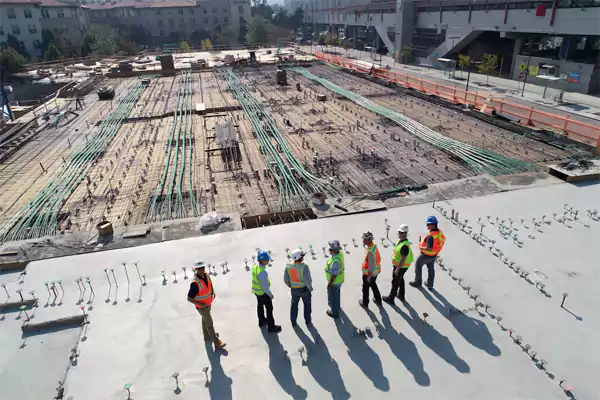Ans: Out of many, these three can be considered the best construction bidding sites.
- Dodge Construction Network
- ConstructConnect
- SmartBid


Whether you are a general contractor, subcontractor, or even the project owner, everyone must learn about construction bidding in detail. No one is supposed to close all the deals for which they have made bids. However, to secure a high ratio, mastering biding basics becomes essential. So, leverage this article and get an elaborate overview of the bidding process in construction. Learn about its meaning, process, stages, elements, key documents, and more! Let’s begin with what this concept means most practically.
Construction bidding is the process where a site owner invites contractors to make bids on a specific project competitively, so that the former has a pool of service providers to choose from. It helps the project owner to come across the best contractor with the lowest bid. A bid is an estimated price that a contractor proposes to charge to complete a project, provided that the other contractors are also competing for the same opportunity.

A Construction bidding package is a set of formal documents prepared by the project owner to send to contractors at large for proposal solicitation. These documents help bidders (or contractors) understand project requirements in the best way, minimising the risk of miscommunication. A construction bidding package often touches upon project requirements, contract type, delivery method, drawings, specifications, scope of work, and more. Without such a package, bidders won’t be able to come up with accurate estimates, leading to inefficiencies.
Also Read: General Conditions of Contract: Complete Guide with Meaning, Types & Examples
Construction project bidding is a competitive process in which project owners solicit proposals from various contractors in order to complete a building project. This process has four stages as mentioned below.
During the process of bid solicitation, contractors are asked by the owner to send proposals to show their interest in a particular project. To make it effective, a project owner can use any of the following documents.
Sometimes, a project owner doesn’t make several requests but just one to demand all types of information needed from contractors.
Now, the property owner requests bids from the interested contractors so that the most affordable option can be found. Generally, contractors consider the following costs to make accurate estimates.
Sometimes, project owners also require bid bonds to be submitted along with bid proposals. This helps make sure that the contractor bid maker doesn’t back out of their promise to complete the project within the agreed-upon amount of money.
Note: If you don’t know how to deal with submittals in construction, educate yourself on this topic thoroughly, from what submittals are to why they are used.
By now, a project owner usually has a pool of well-qualified contractors along with their respective estimations. This is the time when the owner has to narrow down their list of proposals received and reach the best bet for their money. Property owners often choose the most affordable option without having to compromise on quality services.
After a contractor or bid maker has been selected, the final part of the construction bidding process requires making the deal formally locked through the signing of a written contract. So, a contract is formulated and then signed by both parties. It is generally done under the supervision of a construction attorney/lawyer or advocate.
Smart Tip: Being a contractor, never sign any contract unless you have read and understood its implications completely. Otherwise, uncomprehended parts might cause trouble later.
During construction bidding, contractors must pay attention to scope, estimation, timeline, payment terms, and dispute resolution mechanisms. These crucial elements are elaborated below.
All these points make a bid sound professional. Hence, include these aspects while bidding to make an impression or even stand out from the monotonous competition.
There are four types of construction bidding, namely, open tendering, negotiated tendering, selective tendering, and serial tendering. All of these are concisely discussed below.

In this form of bidding, a project owner invites all licensed contractors to participate and submit their best bids. This approach to construction bidding promotes fairness and competition.
Often, government or public projects utilise this method to find the best project manager in the development industry. An invitation for proposals and bidding is published through various marketing channels, and all valid service providers are called upon to respond.
As evident by the name, this form of tendering relies heavily on negotiation and discussion, rather than solely selecting a contractor with the cheapest bid. The project owner communicates directly with several contractors and tries to evaluate which one would be the best option to serve the specific needs of the project.
In this method, out of a large competitive pool, more qualified and desirable proposals are selected first to proceed further. It is an approach that can be best described as a hybrid form of both open and negotiated tendering. After such pre-selection, the property owner discusses terms and conditions of the project with the chosen candidates and then finalises the deal with the most suitable professional.
This form of tendering is used when a series of similar projects need to be constructed over an extended period of time. First, a qualified contractor is selected, and then the same professional can be entrusted with the construction of all similar projects. For example, public authorities might use this method to deliver the renovation of school premises to the same contractor over and over again each year. It helps save time and money, optimising the use of the limited resources.
A contractor just needs to know a few quick steps in order to be ahead of the curve in the construction bidding and its various related aspects.
Pro Tip: Often, the actual costs of construction tend to be higher than the anticipated ones. Thus, it is always a prudent practice to also factor in unexpected costs and potential risks involved in a particular project.
Construction bidding can be a complicated procedure if it isn’t handled effectively by a project owner. On a deeper level, both parties, bid solicitors and bid makers, are required to furnish key documents with optimal clarity and act in the best interest of each other.
Hence, if you are seeking bids from contractors, make sure your construction bidding package offers every piece of crucial information. And, on the other hand, if you are a bidder, create a proposal with accurate estimates and also never forget to boast your expertise and experience to create an edge.
Also Read: 10 Biggest Construction Companies in the US to Know Before Hiring a Contractor!
Ans: Out of many, these three can be considered the best construction bidding sites.
Ans: Yes. Bidding requires time, effort, and resources, which give rise to certain expenses that all contractors have to bear. Such expenditure of money can be considered upfront costs.
Ans: It is a project delivery method. A project owner first has a designer create detailed sketches and drawings of the project. Afterwards, such documents are used to solicit bids from general contractors.